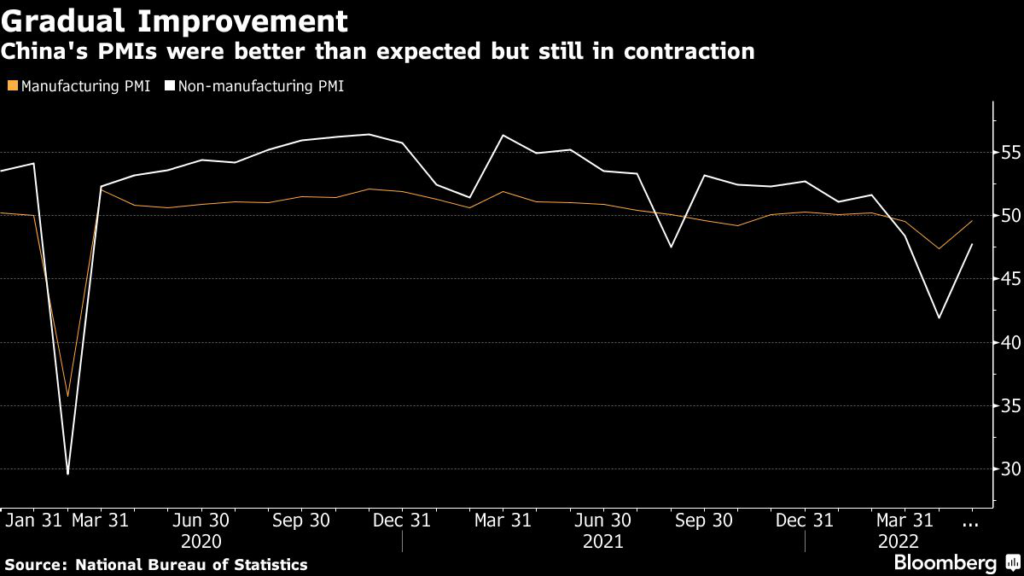(Bloomberg) — China’s factories still struggled in May, but the slower pace of contraction suggests that the worst of the current economic fallout may be coming to an end as the country starts to ease up on its tough lockdowns.
The official manufacturing purchasing managers index rose to 49.6 from 47.4 in April, according to data released by the National Bureau of Statistics on Tuesday. A reading below 50 still indicates a contraction, but the gauge was better than the median estimate of 49 in a Bloomberg survey of economists.
The non-manufacturing gauge, which measures activity in the construction and services sectors, increased to 47.8 from April’s 41.9, above the consensus forecast of 45.5.
While the economy still hasn’t completely turned a corner, the better-than-expected data does suggest that efforts to ease some restrictions are helping companies resume production and putting a floor under the decline in activity. Even so, the pace of recovery will be slow this time around, and economists still predict growth will weaken to 4.5% this year — well below the government’s target of around 5.5%.
Tuesday’s data indicates that “in-contact services sectors are still the epicenter of slowdown while the initial manufacturing sector recovery has been slower,” compared to the 2020 lockdown, said Liu Peiqian, chief China economist at NatWest Group Plc. “We think the pace and scale of recovery might be more gradual.”
What Bloomberg Economics Says …
The surprisingly big gains in China’s May PMIs suggest the worst of the economy’s slump may be over. The data show activity still broadly shrinking — but much less so than in April. Both production and demand saw much narrower contractions in the manufacturing sector.
— Chang Shu and David Qu, economists
Read the full report here
Zhao Qinghe, senior statistician at the NBS, noted the recovery in manufacturing production and demand, though said in a statement that the momentum “still needs to be strengthened.”
China’s benchmark CSI 300 Index closed 1.6% higher, one of the best performers in Asia, with information technology and telecommunications shares the main gainers. The yield on China’s 10-year government bonds climbed 2 basis points to 2.79% as of 5:02 p.m. local time.
Lingering Impact
The outlook for China’s economy has darkened this year amid widespread Covid outbreaks and stringent controls to curb infections.
Lockdowns have begun to ease, allowing for some recovery in activity. And Beijing has tried to support growth through a variety of measures, and recently rolled out a broad support package that covered everything from consumption and investment to tax cuts and loan support. Premier Li Keqiang has also repeatedly called for local governments to do more to stabilize growth, warning of dire consequences if they don’t move decisively.
But the effects of the restrictions on production and supply chains will still likely be felt for months as businesses struggle to restart.
Pressures from supply shocks and a fall in demand “are still severe and the impact of the pandemic on economic growth cannot be underestimated,” said Zhang Liqun, a researcher with the State Council’s Development Research Center, in a statement released by the China Federation of Logistics and Purchasing after Tuesday’s PMI data.
More than 50% of the surveyed companies said raw material prices and logistics costs are high, he said, while over 40% said demand is insufficient. The federation compiles the PMI data alongside the NBS.
Chinese authorities are vigilant about inflationary risks as global commodity prices remain high and the war in Ukraine continues, and are focusing on how to keep food and energy costs in check.
China has enough coal inventory at major power plants for 32 days, said Zhao Chenxin, a vice head of the National Development and Reform Commission, the country’s top economic-planning agency. Oil product and natural gas inventories at key Chinese oil and gas firms are also at high levels, and there is enough to meet demand, he said at a briefing Tuesday.
Even if China manages to right its supply chains and address other risks quickly, any sustained recovery is still challenged by a lack of demand. The threat of a cycle of Covid lockdowns should there be more outbreaks has weighed on business confidence, making them more cautious about expanding. Consumers are also likely save up, rather than spend, if they’re uncertain about the future.
The recovery ultimately comes down to whether China locks down cities in the future, said Iris Pang, chief economist for Greater China at ING Bank NV. If those restrictions continue, “damages on the economy could be deep.”
(Adds details from market close and official comments on energy supply.)
More stories like this are available on bloomberg.com
©2022 Bloomberg L.P.











